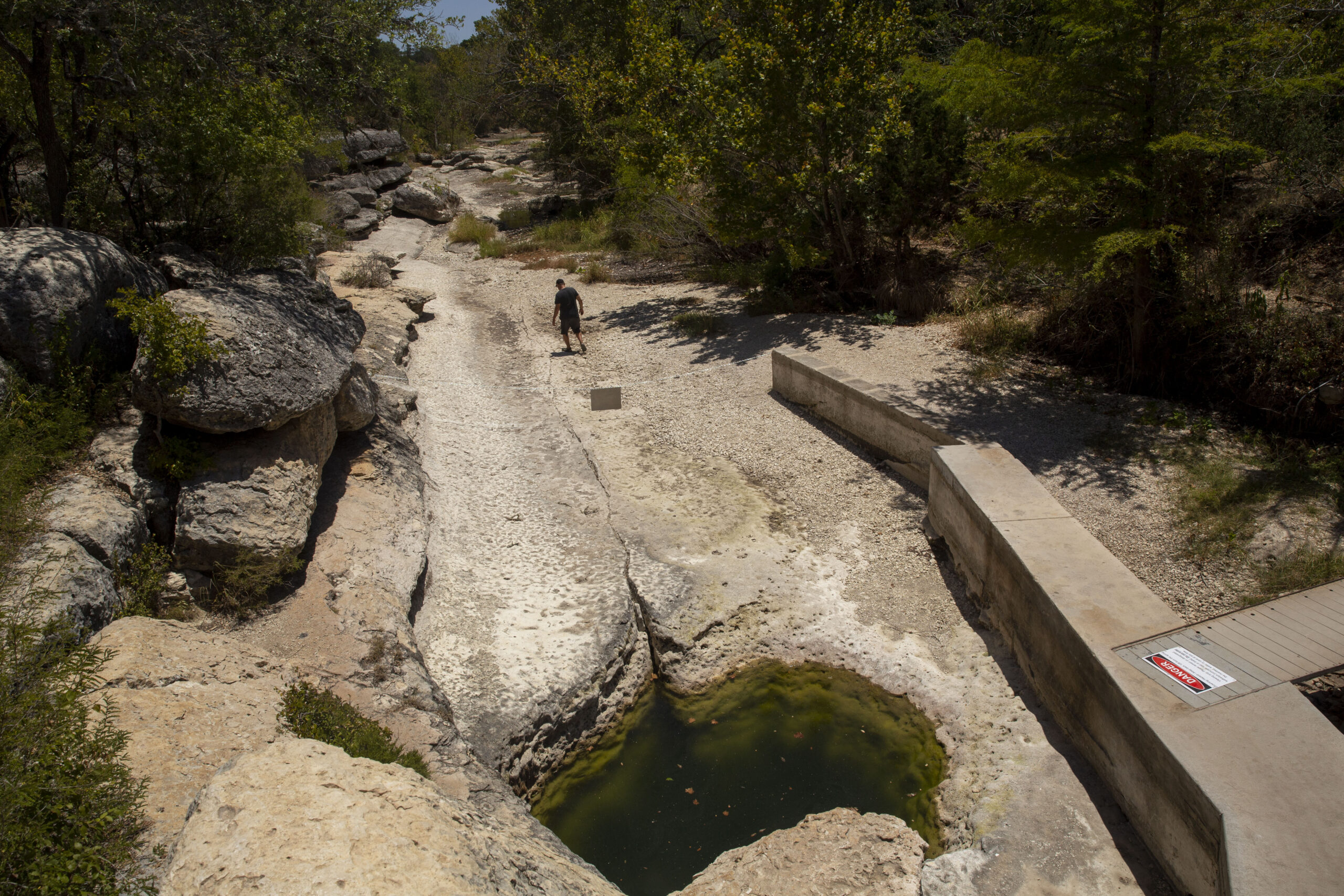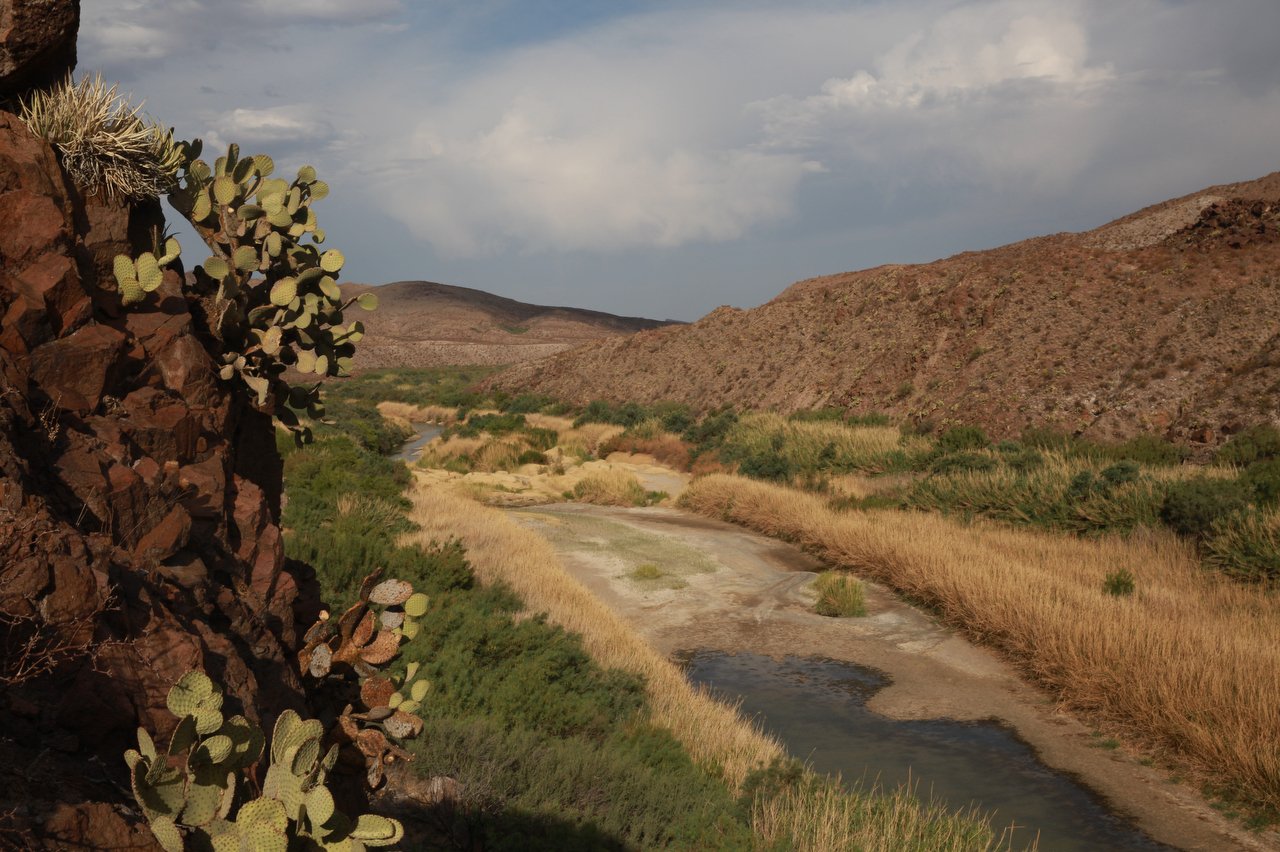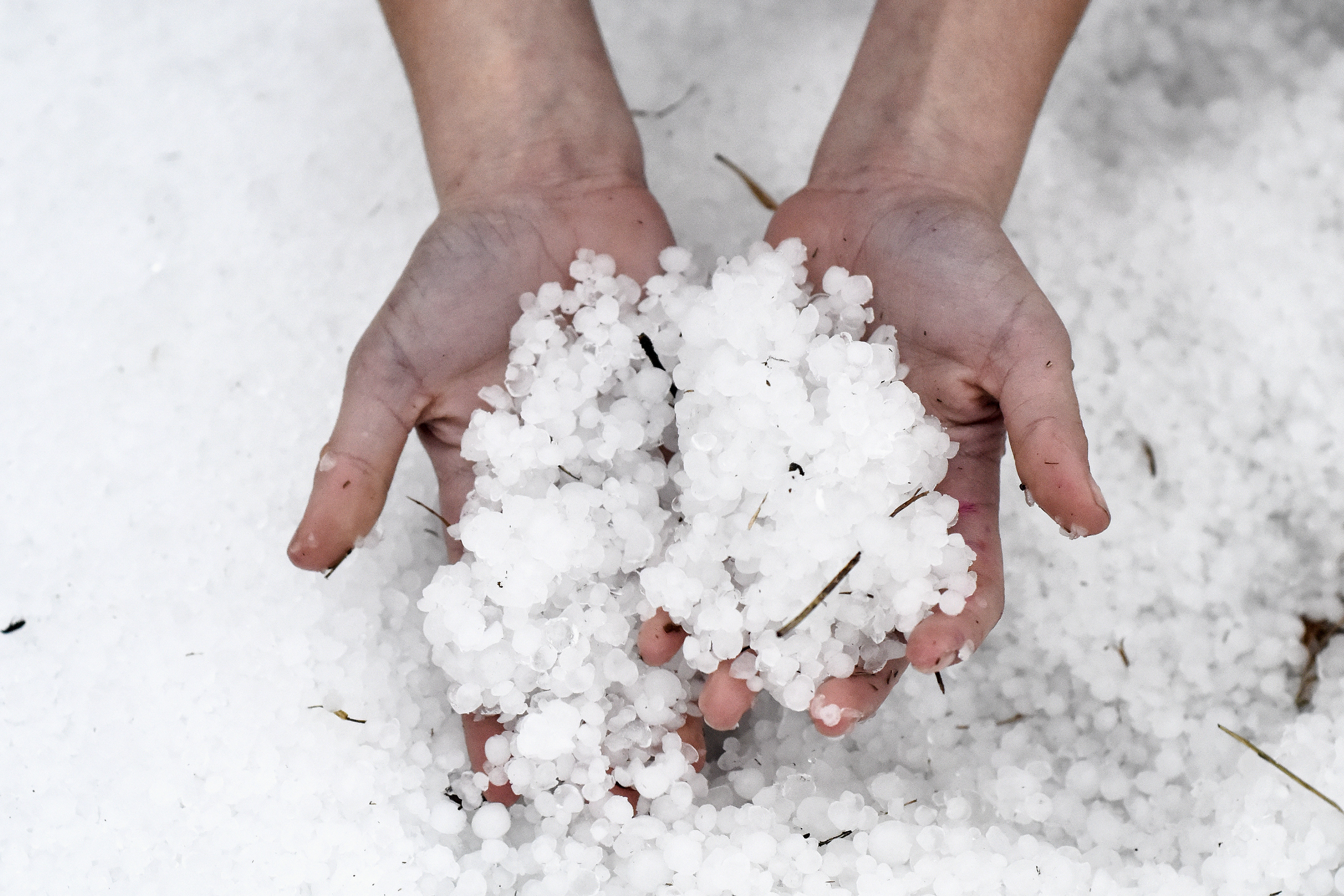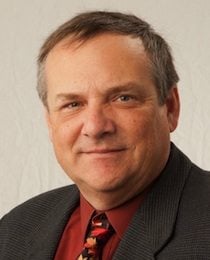
Q&A with State Climatologist John Nielsen-Gammon

This is Part Twelve in an occasional series of Q&As with Texans involved in issues of the environment and energy. (Read Part One with Bee Moorhead here, Part Two with Andy Sansom here, Part Three with Katherine Hayhoe here, Part Four with Patrick Kennedy here, Part Five with Michael Banks here, Part Six with Gabriel Eckstein here, Part Seven with John Nielsen-Gammon here, Part Eight with Tad Patzek here, Part Nine with Charles Porter here, Part 10 with Carlos Perez de Alejo here and Part 11 with Kate Galbraith here.)
In Part Twelve, I talked to State Climatologist John Nielsen-Gammon at the Observer offices in this wide-ranging interview. I last interviewed Nielsen-Gammon for this series in June 2011, in the middle of that summer’s brutal heat. Now, two years later, amid a worsening drought, we sat down to take stock of the drought, discuss the challenges of communicating climate science and ponder the Pacific Multi-Decadal Oscillation.
Although Texas is only two weeks away from setting record low lake levels, it’s also possible that a tropical system developing in the Gulf could bring “drought-busting” rainfall to parts of Texas. Here’s hoping this interview becomes irrelevant by next week!
Texas Observer: How has the drought story evolved in 2013?
John Nielsen-Gammon: I think it was good the drought was still getting people’s attention during the legislative session because they made some progress on long-term water planning issues there. The summer’s been relatively wet in most of West Texas and in East Texas it’s been kinda dry but hasn’t been as dry as it was two years ago. So we’re not really seeing the big agricultural impacts we had a couple years ago, which is good. And it’s been enough to keep the water supplies going in the reservoirs. So we’re sort of holding the status quo, which is not really what you need because you’re still pretty vulnerable.
TO: I think people, especially in cities, think, “2012 was average, at least in this area, and we had some big rainfall events and the plants look pretty good, so why are we in this persistent drought?”
JNG: Part of the answer is meteorological and part of it is the infrastructure has changed. More and more reservoirs have gone up along the Colorado River so there’s water that would’ve been in these reservoirs that is presently in different reservoirs. People have inhabited more of the Hill Country with dense subdivisions and built wells to supply those, which is taking water out of the system also. That hasn’t helped. Then meanwhile we haven’t had a good flood in a while. [Laughs]
Floods are bad for most purposes but they’re great for filling up reservoirs. There were floods along the Colorado River even during the 1950s drought. But we had one back in September 2012, which hit the upper Colorado River and pretty much doubled the amount of water in some of the reservoirs up there and provided a year’s worth of water for San Angelo. That bought them a year to develop an alternative well field. But there hasn’t been a flood around here. You need to have several wet months in a row or something really concentrated. The first thing that happens, the soil gets wet. Either you have the rain come fast enough that it doesn’t have time to sink in or you get enough of it that the soil is already saturated before you get the runoff that goes into the reservoirs.
TO: Back in March you said that by the end of the summer you expected this to be the second worst drought on record beyond only the drought of the 1950s. Are we there yet?
JNG: I think we’re there. I’m basically waiting another couple months until this one outlasts the 1917-1918 [drought]. But I think by most measures we’re pretty much number 2, but to make it official we’re gonna wait till the end of October.
TO: Who gets to decide that? Obviously you can do whatever you want. And what is the criteria?
JNG: Apparently I can, actually. There’s nobody that—well, the governor’s responsible for declaring drought emergencies and requesting federal assistance if necessary. But in terms of the meteorological conditions a few droughts ago I noticed that nobody was saying when the drought was over so I figured I’ll do it. [laughs]
TO: Well, you are the state climatologist and not some guy on the street.
JNG: So it makes sense for me to do it.
To: When you’re doing a comparative analysis of this drought vs that drought, what is the basis for measuring that sort of thing?
JNG: There are lots of different drought indices used to measure the severity of drought. The most common one is the Palmer Drought Severity Index. I’ve got this diagram where I plot the evolution of the index over time for all of the droughts in Texas since 1895 and by two months from now it will be the third longest-lasting drought and it bottomed out in terms of intensity pretty much on par with the 1950s drought. It was slightly worse on the index value than it was in 1956. But meanwhile it’s been more severe overall than the other longest-lasting drought, which was the early 1960s, which really wasn’t a major drought from a Texas impacts point of view. In terms of duration the only competition for second place is the 60s drought and in terms of intensity this one’s been worse.
TO: What would it take to say this has been the worst drought in Texas recorded history. How do we get to that point? How much longer would that take, what would the conditions need to be?
JNG: That is not as relevant for actual impacts as when this drought becomes the drought of record for particular water suppliers which is going to happen at different times in different places. I think this has already been the drought of record in some places. If it keeps going it will continue knocking down those records. The basis for water supply infrastructure is to be able to withstand the drought of record, which is great until you have the drought that surpasses it. We’re finding out what happens in that circumstance.
TO: So the drought of record is not just a fun record. It has significance for the purposes of water planning, for the water suppliers.
JNG: In principal you could plan for some kind of engineering standard, like a 1 in a 100 probability event happening. The advantage of using the drought of record standard from the [Texas] Water Development Board’s point of view is it’s a concrete event where you can calibrate and test models and make sure your models are performing the way they should. You can’t necessarily do that for a more abstract quantity.
TO: In a sense it’s not that conservative because the period for which we have records is kind of a blink of the eye in geologic history and then we have the enhancing effects of climate change. Do you think the drought of record is the proper yardstick for planning purposes or should there be some other approach?
JNG: Well, I think first you have to say what level of risk you want to allow, how resilient you want the water supply to be. I would think based on how severe and long term the consequences would be of having a water shortage in a major metropolitan area—I’m talking about economy, future industrial development and so forth—you really want to insure against something like that happening. I would think something like a 1 in 300 or 1 in 500 possibility in any given year would be a more reasonable planning target. That would suggest something more resilient than what would withstand the drought of record.
Now, on the other hand, the criterion is something like, in the drought of record you still have to supply all the water needs but needs are not necessarily necessary, relative to how much water you have. A household can get by with much less water than it thinks it needs, for example. There are problems with both ends of the scale.We need to be able to withstand the more severe drought but we also have to accept that in a more severe drought we’ll have less water than we want.
TO: How long do you expect this drought to last? You said sometime back that looking at the cycles of the past and the cycles we’re in presently that this drought could last through the end of this decade.
JNG: That’s certainly possible. I’m not wrong yet. [Laughs] It takes a lot longer to get in a drought than it does to get out of it. A couple of tropical disturbances that camp over the state would provide a lot of water, having several wet years in a row, like an El Niño event. We haven’t had an El Niño event during this drought . It could happen, not this winter, but possibly next winter. So you can’t really say more than a few months in advance whether a particular drought is likely to end or not. But over the long term the signals are still pointing towards drought.
TO: I think many, if not most,Texans are familiar with the El Niño/La Niña cycle and how it impacts our weather here but from what I understand we’re learning more about how the Atlantic Multi-Decadal Oscillation and how the Pacific Decadal Oscillation function, how they might influence Texas weather. What can you tell us about our friends ADO and PDO?
JNG: PDO is sort of like the long-term, slower version of El Niño except it has more of a signal at higher latitudes in the Pacific. They’re closely related and some people speculate that they’re really just the same thing looked at in two different ways. In terms of consequences, it really is similar to El Niño and La Niña when the index is positive we tend to have wet winters when it’s negative we tend to have dry winters. We’re negative now, of course and have been basically since the beginning of the century.
When the North Atlantic is warm it probably tends to lead to dry conditions in Texas, especially during the summers. And I say probably because we don’t have a consensus among all the different model that simulate the atmosphere. Some of them show a connection and some of them don’t. The historical evidence shows a connection, so it’s probably there, it’s probably a shortcoming of the model. But you can’t know it for sure because the Atlantic Ocean has only been cold, then warm, then cold, then warm during the climate record and that’s not many instances to build up solid statistics.
Assuming it’s real, the Atlantic has been running warm over the past 15 years or so and so that also favors dry conditions, mainly dry conditions in late summer and fall. There doesn’t seem to be anything that strongly affects the springtime rain. We’ve got different parts of the climate system hitting us at different times of the year right now.
TO: Going back to 2011, I remember you produced a chart plotting temperature and precipitation. 2011 was almost literally off the charts. People want to know: Is this just some crazy outlier year that we would have had regardless of climate change, is it caused by climate change or is climate change just a factor that works on top of natural variability?
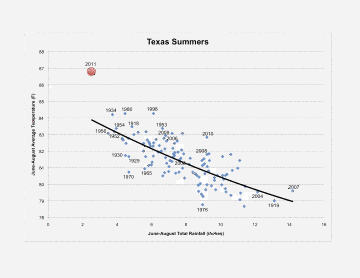
JNG: We know from the past that the drier it is the hotter it tends to be in the summertime. Both 2012 and 2013 have not been outliers on the diagram. They’ve been near the middle of the cluster of points. 2011 was an unusual single event. The climate change aspect of it is that really for the past 10 or so summers the temperatures have been higher than you would expect for the amount of precipitation we got. In other words, a six inch summer would normally be 83 degrees and instead it was 84 degrees, something like that, for average of the maximum and minimum temperatures. So climate change is making things tend to be more of an outlier along the temperature part of the distribution but the thing that really affects temperature the most is rainfall. That was the big player in 2011.
TO: You tried to calculate what fraction of 2011 was due to global warming. What did you come up with?
JNG: Compared to the normals for 1981 to 2010, climate change seemed to be responsible for a degree Fahrenheit, so about 20 percent of the anomaly during that period. There’s a couple of qualifications to that. We’re only one year after the normal averaging period so effectively that’s just 15 years of climate change from the middle of that 30-year period to 2011 is sixteen years. A degree in 16 years is pretty substantial.
If you went back to the beginning of the century, how big of a change would you get? Well, that’s the other footnote because in Texas the average from 1981 to 2010 temperatures for summer pretty much matches the long-term average. We hadn’t experienced long-term warming in the state until recently. And maybe natural variability was masking some of that; it probably was. But that means we can’t say overall how much of a contribution climate change has at any given location, such as in Texas. Climate change and natural variability are all tangled up and both are contributing. It’s hard to be precise in terms of the relative impact of each of them when you don’t have something else to verify against.
TO: Why do you think as the state climatologist, as a climate scientist, why do you think communicating climate science to the public can be so difficult?
JNG: Oh, I think it’s easy to communicate climate science to the public. They do it all the time. It doesn’t even have to be accurate.
TO: And of course a lot of it is filtered through the media. Here I am.
JNG: And filtered through people’s perceptions. And different interest groups have different messages they want to convey. And, frankly, the climate system is so complicated that there’s no way that anybody in the public without a sense of scientific background is going to be able to evaluate different claims made about the climate scientifically. They really have to rely upon judging information by its source and that sort of thing.
Back in the 1950s and 1960 we might not have had this sort of polarization problem because we didn’t have multiple sources. Scientific information was regarded as basically right or wrong. Science writers were trying to explain things to the public. The public was interested in science through the nuclear revolution to the development of computers. We didn’t have fragmentation of scientific messages and that combined with the expertise of science reporters made for pretty good information going to the public.
Now with the climate science issue, there are many multiple messages. People will hear different things from the media they prefer, they have more ability to focus on particular media sources so we don’t get the broad information that happened when all the media was essentially trying to speak to everybody simultaneously.
TO: I think there’s a significant percentage of the public that, for example, challenges the greenhouse gas effect as a phenomenon, doubts its existence, in a way that I don’t think you see in other fields like physics. Do you attribute that to this bifurcation in the way that people get information, usually mediated through the media or is there something more fundamental at work there?
JNG: I think it really is the bifurcation. There’s not a lot of sources out there to say, well the greenhouse effect doesn’t even really work. You can find the odd scientist here and there, none of them climate scientists, that say it doesn’t work. I think because most of the public is not going to know the ends and outs of the various issues, the only thing they really care about—with justification—is, Is this something they need to be concerned about or not? And if the allusion is not, then that means the people saying it is something to be concerned about are wrong about what they’re saying. And everything they say will tend to go, by default, into the quote-unquote wrong category.
It’s not that a large portion of the public doubts the greenhouse effect, it’s that they doubt climate change is a serious problem and if they’re going to have to guess about a scientific question they will guess in the direction of those saying it’s not a serious problem. But ask any one of them to explain what’s wrong with the greenhouse effect, or ask someone who believes it’s real, how it works, 95 percent will not be able to give you a scientifically valid explanation.
TO: What do you make of the assertions, especially from politicians, that warming has stopped? Typically 1998 is cited as the year that global warming has stopped. And we know there is a plateau in the past decade or so when we look at land surface temperatures—
JNG: And ocean surface.
TO: What’s actually going on with the climate system and what are those folks getting wrong, if anything?
JNG: It’s all basically a matter of messaging. No, not all, but largely a matter of messaging. Have temperatures gone up a lot over the past decade? No. Does that mean global warming has stopped? Well, that depends on whether you define global warming as temperatures steadily increasing over a decade interval. If you define it like that, then yeah it has [stopped]. If you define global warming as a long-term increase in temperature caused by greenhouse gas increases, then has that long-term increase stopped? No. The short-term increase has stopped.
Scientifically there is always going to be natural variability to make things go up faster or slower. To be fair, when temperatures are going up faster, scientists didn’t take the initiative to figure out if part of that was natural. It was consistent with the rate models were increasing so there wasn’t any evidence it was too fast. Now that it’s slowed down, again temporarily, just as it was going up too fast temporarily, it’s become apparent that the models either don’t have enough natural variability or are overestimating the long-term trend, or both.
Scientists always knew that they were screwed up with natural variability of years to decades. Some models can do pretty well with El Niño summers. Multi-decades things, it’s hard to say they’re very good at it. But that wasn’t the goal of the models. It would be nice if the models were accurate in all things but the main emphasis was to have them be accurate in terms of the long-term magnitude of climate chance. Scientists weren’t too worried about not having things right from decade to decade. Now they are, belatedly I think, and we’re starting to see the results of research looking at the issue. Actually, there’s stuff coming out every day now.
The thing that points to it being a natural fluctuation is the fact that the ocean is continuing to warm up. That means we still have the energy imbalance that we put into the atmosphere. That hasn’t gone away and the surface temperature pendulum is going to swing back eventually. Meanwhile the long-term increase may need to be adjusted downwards as a result of this.
TO: From a policy perspective, is it good news because it buys the planet more time to try to address greenhouse gas emissions or is it bad news because it allows some folks to exploit the message and say climate change isn’t an issue and therefore leads to inaction? Or is it all a wash?
JNG: If it’s just a temporary thing that we’ll go back up and catch up to the rate we were warming before, then it’s bad news. It won’t have any long-term benefit to the climate system and it will delay action. If we’re down to, say, the minimum of a natural oscillation that’s superimposed on the long-term trend and we were above that before, hitting our peak in ’98, then it’s good news in the sense that the long-term trend is lower than what we thought it was. But the adjustment we’re talking about there is 20 percent or 25 percent lower, at the outside, which is small compared to the uncertainties. [Laughs] Such as how much we value things in the future versus the present, or how big the impacts are going to be for a given change in temperature. It’s not going to have a policy impact; it’s going to have an impact down the road on how things actually turn out. It doesn’t make any difference in the argument.
TO: Any final thoughts?
JNG: I think we got it covered.
